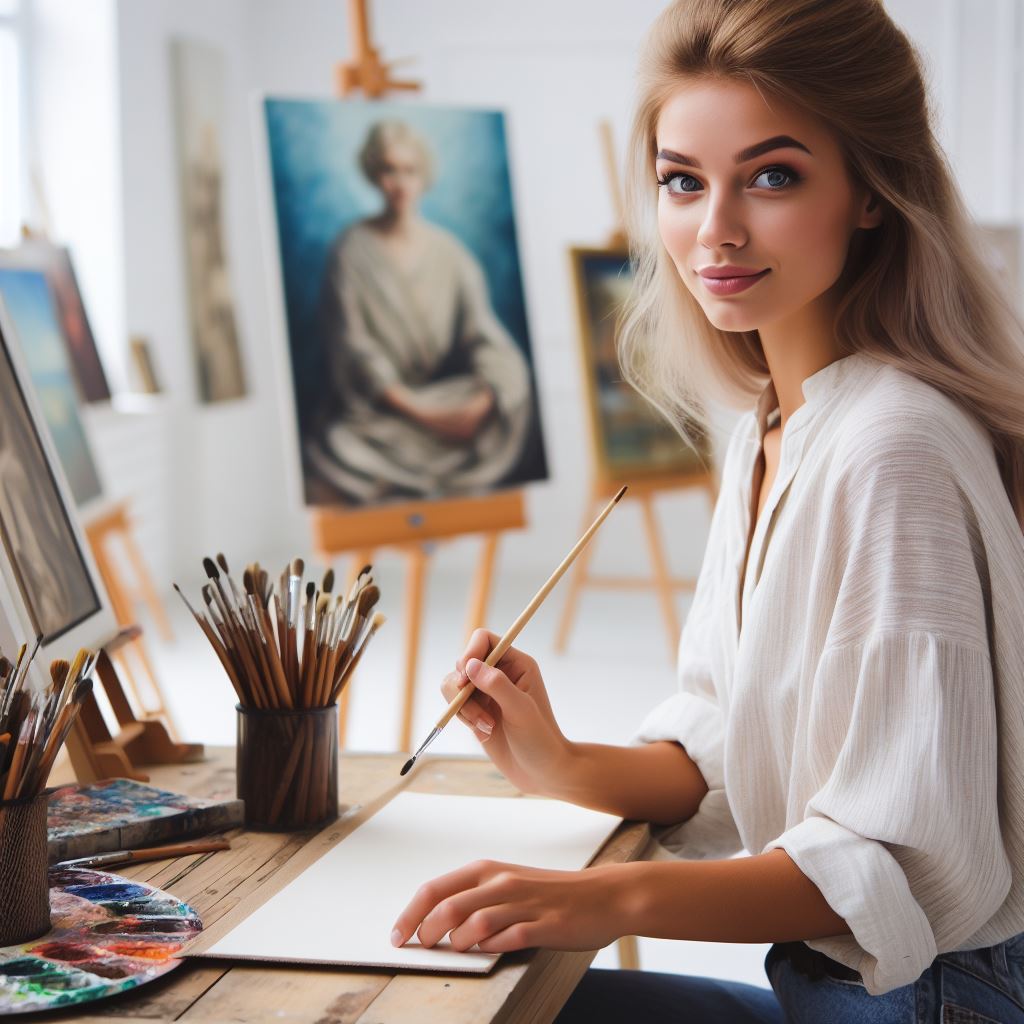Introduction
Effective display techniques are crucial for professionals in various fields, as they play a vital role in capturing attention, conveying information, and enhancing visual appeal.
In the UK, the art of display is highly valued and widely practiced.
Whether it’s in retail, museums, galleries, or even presentations, the way products, artworks, or ideas are presented can make a significant difference.
The art of display involves utilizing various techniques to create visually captivating and engaging arrangements that effectively communicate messages.
In the world of retail, for example, effective display techniques can entice customers, highlight products, and ultimately drive sales.
By carefully arranging products, using color schemes, and incorporating strategic lighting, retailers can create an inviting atmosphere that draws customers in and encourages them to make purchases.
In museums and galleries, the art of display is essential for showcasing artwork or artifacts to their full potential.
Curators focus on arranging pieces in a manner that enhances their aesthetic appeal and facilitates the understanding and appreciation of visitors.
Lighting, spacing, and the choice of supporting elements all play crucial roles in creating impactful exhibits.
Effective display techniques also extend to the realm of presentations and public speaking.
Whether it’s through the use of well-designed slides, props, or visual aids, presenters can capture and maintain their audience’s attention, making their message more memorable and compelling.
In short, the art of display is a significant aspect of various professions in the UK.
By mastering effective display techniques, professionals can enhance their ability to engage, communicate, and leave a lasting impression on their audiences.
Visual Merchandising in Retail
The significance of visual merchandising in the retail industry
Visual merchandising plays a significant role in the retail industry, as it aims to attract customers and enhance their shopping experience.
Through creative displays, retailers can effectively communicate their brand’s message and showcase their products to potential buyers.
Personalized UK Career Consulting
Receive tailored career guidance designed just for you. Get actionable steps and expert support to boost your career in 1-3 days. Take control of your career now.
Get StartedPopular UK techniques used for product displays
In the UK, there are several popular techniques used for product displays that have proven to be successful.
One such technique is window dressing, where retailers create eye-catching displays in their store windows to grab the attention of passerby.
These displays often feature the latest trends or highlight specific products, enticing customers to enter the store.
Another common technique is the use of mannequins. UK retailers excel in creating visually appealing outfits on mannequins, showcasing how different pieces can be combined to create a stylish look.
By presenting customers with complete ensembles, retailers can inspire them and encourage additional purchases.
In addition to window displays and mannequins, product grouping is also a popular technique in the UK.
Retailers strategically place related items together, such as accessories displayed alongside clothing or kitchenware arranged near recipe books.
This technique helps customers visualize how products can be used together and increases the chances of cross-selling.
Creating a sense of ambiance is another crucial aspect of visual merchandising in the UK.
Retailers pay attention to lighting, music, and even scent to create a specific mood that aligns with their brand image and target audience.
For example, a high-end boutique may use soft lighting and classical music to evoke a luxurious and sophisticated atmosphere.
Examples of successful visual merchandising campaigns in the UK
Successful visual merchandising campaigns in the UK include those executed by renowned department stores.
Selfridges, for instance, is known for its extravagant window displays that often incorporate art installations and innovative design elements.
These displays not only attract attention but also generate buzz and media coverage, further enhancing the brand’s image.
Your Dream Job Starts with a Perfect CV
Get a tailored CV and cover letter that captures your unique strengths and stands out in your industry. Let us help you make an unforgettable first impression.
Get StartedSimilarly, Harvey Nichols is celebrated for its creative use of mannequins.
The retailer frequently collaborates with fashion designers to create unique and attention-grabbing displays that captivate passersby.
By showcasing avant-garde designs and pushing boundaries, Harvey Nichols sets itself apart from competitors and establishes itself as a trendsetter.
Another notable example is John Lewis, which excels in product grouping.
With its thoughtfully curated displays, the retailer effectively presents products as part of a larger lifestyle concept.
For instance, they may create a display featuring home furnishings, tableware, and recipe books to inspire customers to create a stylish and cohesive home.
In fact, visual merchandising plays a crucial role in the retail industry in the UK.
Through techniques such as window dressing, mannequins, product grouping, and creating ambiance, retailers can effectively engage customers and drive sales.
Successful campaigns executed by popular department stores like Selfridges, Harvey Nichols, and John Lewis serve as inspiration for other retailers looking to enhance their visual merchandising strategies.
Read: Networking Tips for Merchandisers
Exhibition Design in the Art and Culture Sector
Exhibition design plays a crucial role in showcasing art and culture, creating immersive experiences for visitors.
The role of exhibition design in showcasing art and culture
Exhibition design is essential in bringing art and culture to life, transforming mere objects into captivating narratives.
Moreover, it enables curators to shape the visitor’s journey, enhancing their understanding and appreciation of the artworks.
Notable display techniques used in UK museums and galleries
- Lighting: Carefully designed lighting highlights specific artworks, creating dramatic effects and drawing attention to details.
- Spatial arrangement: Thoughtful placement of artworks within the exhibition space allows for coherence and meaningful connections to be established.
- Interactive displays: Incorporating interactive elements engages visitors and encourages active participation, enriching the overall experience.
- Audiovisual installations: The use of sound, video, and multimedia installations adds depth and emotion to the exhibition, enhancing the viewer’s engagement.
Innovative approaches to exhibition design in the UK
- Technology integration: Many museums and galleries in the UK have embraced technology, using virtual reality, augmented reality, and digital displays to enhance visitor experiences.
- Immersive environments: Creating immersive environments, such as reconstructions or replicas, transports visitors to different time periods or places, enabling them to fully immerse themselves in the art and culture.
- Multi-sensory experiences: Incorporating different senses, such as touch, smell, and taste, can provide a more holistic understanding of the artworks and cultural artifacts.
Benefits of innovative exhibition design
- Enhanced visitor engagement: Innovative exhibition design captivates visitors, encouraging them to spend more time exploring and interacting with the artworks.
- Accessibility for diverse audiences: Innovative approaches can make art and culture more accessible to a wider range of audiences, including those with disabilities or limitations.
- Reinforcing learning outcomes: Creative exhibition design can reinforce educational goals, effectively communicating complex concepts and ideas to visitors.
In essence, exhibition design is a fundamental aspect of showcasing art and culture in the UK.
Optimize Your LinkedIn for Success
Boost your LinkedIn profile with a professional bio, keyword-rich headline, and strategic recommendations that attract recruiters. Stand out from the crowd and get noticed.
Optimize NowNotable techniques such as lighting, spatial arrangement, interactive displays, and audiovisual installations are employed to create immersive experiences.
Further innovation, through technology integration, immersive environments, and multi-sensory experiences, continues to push the boundaries of exhibition design.
These approaches not only enhance visitor engagement but also increase accessibility and reinforce learning outcomes.
Read: Building a Merchandising Portfolio

Interior Design and Decorative Displays
The impact of interior design and decorative displays in various settings
Interior design and decorative displays play a significant role in creating visually appealing spaces in various settings.
The impact of these elements can be seen in homes, offices, retail stores, and other public spaces.
In the UK, there are specific techniques that are widely used to create stunning interiors.
UK techniques for creating visually appealing spaces
Colors and Textures
One of the key techniques used in interior design is the strategic use of colors and textures.
Different colors evoke different emotions and can set the mood of a space.
In the UK, designers often opt for a neutral color palette with pops of bold colors to create a balanced and visually pleasing look.
Texture is another crucial element that adds depth and visual interest to a space.
The use of various materials such as wood, metal, glass, and fabrics can create a rich and layered effect.
Lighting
Lighting has a significant impact on the overall ambiance of a space. In the UK, designers focus on creating well-lit environments that enhance the beauty of the interior decor.
They combine different lighting techniques, including ambient lighting, task lighting, and accent lighting, to create a dynamic and visually appealing space.
The use of natural light is also favored, as it adds warmth and brings the outdoors inside.
Furniture and Layout
The choice of furniture and its arrangement can make or break the interior design of a space.
In the UK, designers often opt for furniture pieces that are both functional and aesthetically pleasing.
They carefully consider the scale and proportions of the furniture to ensure a harmonious layout.
The arrangement of furniture is strategic, with a focus on creating conversation areas, maximizing traffic flow, and utilizing the available space efficiently.
Art and Decorative Objects
Artwork and decorative objects are essential elements in interior design as they add personality and character to a space.
In the UK, designers curate collections of artwork, sculptures, and decorative objects that reflect the client’s taste and style.
These pieces are strategically placed to serve as focal points and create a visual impact. The use of artwork and decorative objects also adds layers and texture to the overall design.
Display Techniques
The way decorative objects, accessories, and products are displayed can greatly impact the aesthetics of a space.
In the UK, designers pay attention to detailing and use various display techniques to create visually appealing arrangements.
These techniques include color coordination, symmetry, asymmetry, grouping, and layering.
Each display is carefully curated to showcase the beauty and essence of the items while maintaining a cohesive look.
Examples of Well-Executed Interior Design and Decorative Displays in the UK
- The Victoria and Albert Museum in London showcases exquisite interior design and decorative displays. The museum’s interiors are a mix of traditional and contemporary elements, creating a visually stunning environment.
- The Ham Yard Hotel in London boasts impeccable interior design with each room uniquely decorated. The use of vibrant colors, luxurious fabrics, and carefully curated artwork creates a visually appealing and inviting ambiance.
- Harrods in London is renowned for its captivating window displays. The displays are meticulously designed to showcase the latest trends and products, creating a visually striking experience for passersby.
In general, interior design and decorative displays play a vital role in creating visually appealing spaces.
In the UK, designers utilize techniques such as color and texture, lighting, furniture and layout, art and decorative objects, and display techniques to craft stunning interiors.
The examples mentioned above demonstrate the successful execution of these techniques in different settings.
Read: UK Retail Laws for Merchandisers
Window Dressing in Fashion and Luxury Brands
Window dressing is an essential element in the fashion and luxury industries, as it serves as a powerful tool to attract customers and create a captivating brand image.
Importance of Window Dressing in the Fashion and Luxury Industries
- Creates an Impression: Window displays are the first point of contact between a brand and potential customers. They provide a visual representation of the brand’s identity, style, and quality.
- Increases Brand Awareness: Well-designed window displays grab attention and leave a lasting impression on passersby, helping to create brand recognition and recall.
- Showcases Creativity and Innovation: Fashion and luxury brands often use window dressing to display their artistic flair, showcasing their latest collections and unique designs.
- Sets the Tone: The ambiance and atmosphere created by window displays can set the tone for a customer’s shopping experience, drawing them into the store.
Popular UK Techniques for Creating Captivating Window Displays
- Storytelling: Using window displays to tell a visually compelling story can captivate and engage customers, creating an emotional connection with the brand.
- Visual Merchandising: The strategic arrangement of products, props, and visuals within a window display helps create an eye-catching composition.
- Lighting: Appropriate lighting techniques enhance the overall impact of window displays, drawing attention to key elements and creating a desired ambiance.
- Seasonal Themes: Incorporating seasonal elements and trends in window displays helps in attracting the attention of customers with relevant and timely visuals.
- Interactive Elements: Adding interactive features such as touchscreens or virtual reality experiences in window displays can create a memorable and engaging brand experience.
Examples of Successful Window Dressing Campaigns by UK Fashion and Luxury Brands
- Burberry: Known for their innovative approach to window dressing, Burberry once created a holographic display in their London flagship store, featuring models walking in the air.
- Selfridges: This renowned department store in London is famous for its elaborate window displays, which often feature avant-garde designs and collaborations with artists.
- Alexander McQueen: The brand has created visually stunning window displays inspired by nature, incorporating intricate floral arrangements and ethereal elements.
- Harrods: Harrods is renowned for its extravagant and opulent window displays, especially during festive seasons, using luxurious fabrics, elaborate props, and intricate details.
- Vivienne Westwood: This iconic British designer often incorporates socio-political messages in her window displays, making a bold statement and sparking conversations.
In a nutshell, window dressing plays a vital role in the fashion and luxury industries, serving as an effective marketing tool to attract customers, enhance brand image, and create unforgettable shopping experiences.
Moreover, by using various techniques and unleashing creativity, UK fashion and luxury brands have successfully elevated window displays to an art form.
Read: Eco-Friendly Practices in Merchandising
Conclusion
Effective display techniques play a crucial role in various professions in the UK.
With the right approach, they can enhance communication, engagement, and professionalism.
Moreover, by implementing these techniques, professionals can effectively convey their message, captivate their audience, and make a lasting impression.
Whether you are in sales, marketing, education, or any other field, the art of display can elevate your performance and enhance your success.
We encourage our readers to explore and implement these techniques in their respective fields.
By doing so, they can improve their communication skills, engage their audience, and ultimately achieve their professional goals.
So, why not take advantage of the power of effective display techniques and make an impact in your profession today?
Start experimenting and see the difference it can make in your career.
Remember, a powerful and persuasive display can be the key to success in any profession.
Invest in learning and honing your display skills, and watch your professional life flourish.
[E-Book for Sale]
500 Cutting-Edge Tech Startup Ideas for 2024 & 2025: Innovate, Create, Dominate
$19.99 • 500 Tech Startup Ideas • 62 pages
You will get inspired with 500 innovative tech startup ideas for 2024 and 2025, complete with concise descriptions to help you kickstart your entrepreneurial journey in AI, Blockchain, IoT, Fintech, and AR/VR.




